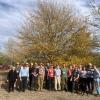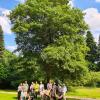Editor's Picks
Plant Focus
Poster presented at the XX International Botanical Conference, Madrid, Spain, July 21–27, 2024.
Authors:
Pere M. Mir-Rosselló1, Antoni J. Far1, Marcello D. Cerrato1, Lluís Salom-Vicens1, Carles Cardona1,2, Marc Carriquí1, Maria José Clemente-Moreno1, Jaume Flexas1, Llorenç Sáez3, Llorenç Gil1
Affiliations:
1. Universitat de les Illes Balears, Palma, Spain
2. Centre Forestal de les Illes Balears, Escorca, Spain
3. Universitat Autònoma de Barcelona, Barcelona, Spain
Abstract:
Epiphytes depend on the microclimatic conditions generated by their phorophytes (illumination, temperature, humidity, etc.). Climate change is expected to increase extreme climatic events in the Mediterranean Basin, such as drought, heat waves or intense storms and hurricanes. Intense storms can physically damage trees, affecting their canopy or even killing them. This can affect epiphytes due to their sudden exposure to harsher conditions. During February 2023, the squall Juliette heavily affected many Quercus ilex forests in Mallorca. In this study, we aimed to evaluate the effect of Q. ilex canopy damage due to Juliette on three epiphytic mosses (Leucodon sciuroides, Leptodon smithii and Homalothecium sericeum). Treatments consisted in 1) plants still covered from unaffected trees, 2) plants previously uncovered from unaffected trees, and 3) plants exposed after their phorophyte was affected (canopy damage) by Juliette. Light availability in all three treatments was first characterized with a PAR sensor. Chlorophyll fluorescence (Fv/Fm), oxidative stress biomarkers and mortality rates were monitored in each species during April and December 2023. Fv/Fm decreased in newly exposed plants of L. sciuroides and H. sericeum, and did not significantly change in L. smithii. Surprisingly, mortality rates remained relatively low in all three species, and remaining zero in many samples. Our results suggest that, although being physiologically affected, the three selected species showed a certain degree of resistance to sudden environmental exposure due to canopy damage in their phorophyte. Although these mosses have shown a notorious survival capacity, further studies should be conducted to better assess the presented problem in other epiphytes such as liverworts or lichens, and how epiphytic communities will change after canopy damage.
















